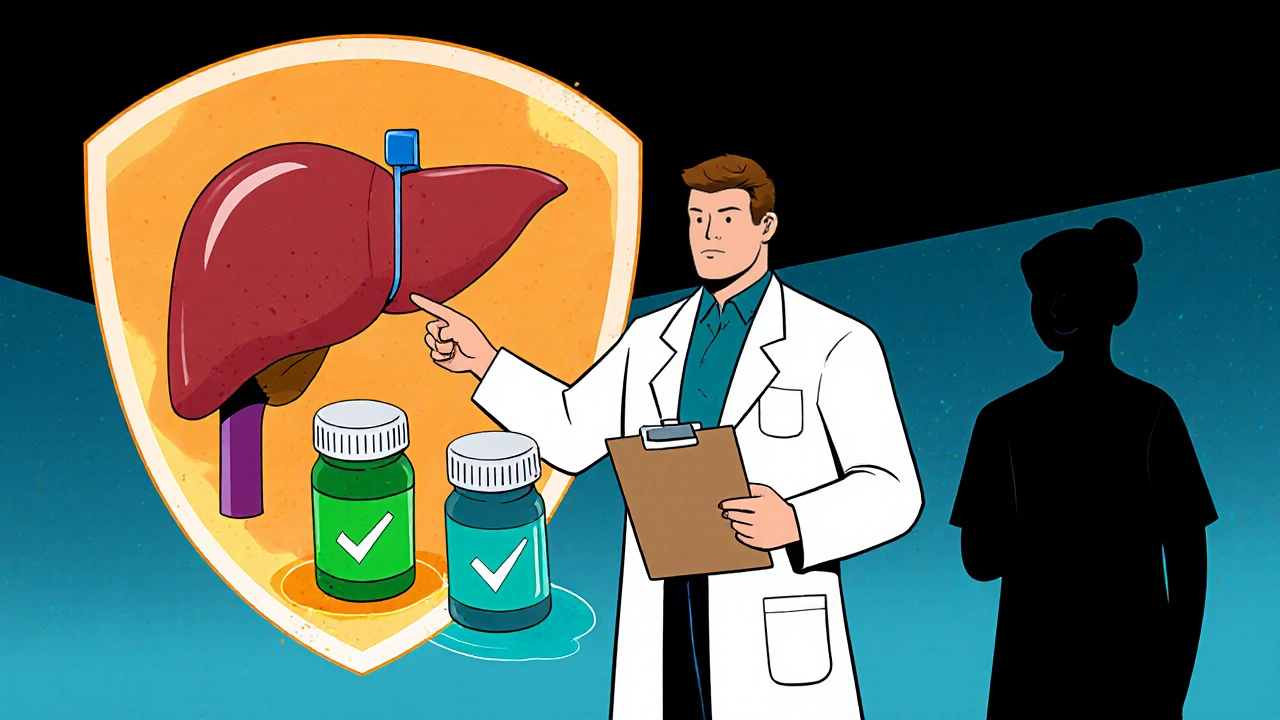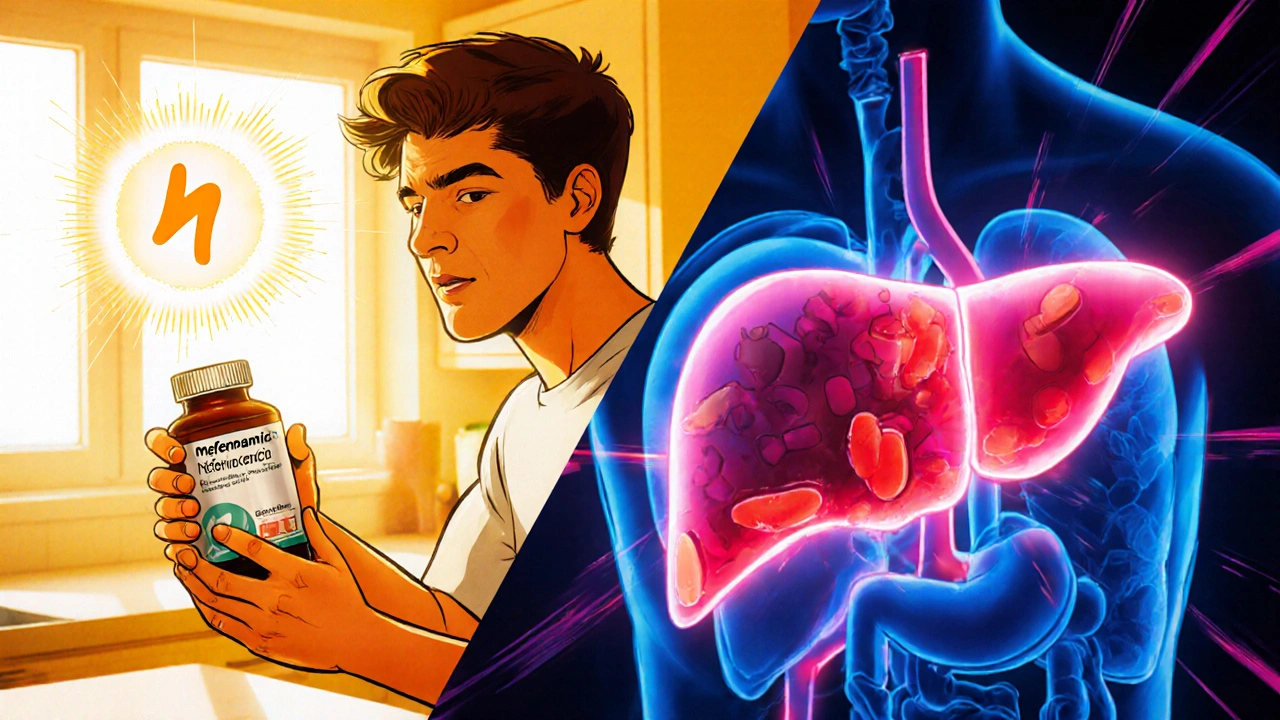When you pop a painkiller, you expect relief, not a surprise visit to the doctor. Mefenamic acid is a non‑steroidal anti‑inflammatory drug (NSAID) often prescribed for menstrual cramps, dental pain, and musculoskeletal aches. While it’s effective, its impact on the liver toxicity profile can be a hidden concern, especially for people who already have liver issues or who take other meds that stress the organ.
Key Takeaways
- Mefenamic acid can cause liver enzyme elevations in a small but notable percentage of users.
- Risk spikes with high doses, prolonged use, alcohol use, and pre‑existing liver disease.
- Early symptoms include fatigue, nausea, abdominal pain, and dark urine.
- Regular liver‑function testing (ALT, AST, bilirubin) is the most reliable safety net.
- Safer NSAID alternatives such as ibuprofen or naproxen may be preferable for at‑risk patients.
What Is Mefenamic Acid?
First approved in the 1960s, Mefenamic acid belongs to the anthranilic acid class of NSAIDs. It works by inhibiting cyclooxygenase (COX‑1 and COX‑2) enzymes, curbing the production of prostaglandins-the chemicals that cause pain, fever, and inflammation.
The drug is typically taken 250mg three times daily for up to a week. Because of its relatively short half‑life (about 2hours) and rapid absorption, it provides quick pain relief, but the same rapid metabolism also means the liver sees a high concentration of the drug shortly after ingestion.
How the Liver Handles NSAIDs
The liver is the body’s chemical processing plant. When you swallow an NSAID, enzymes in the liver-especially the cytochrome P450 family-modify the drug so it can be eliminated. Cytochrome P450 enzymes (primarily CYP2C9 for many NSAIDs) convert the medication into metabolites that are either excreted in urine or bile.
During this conversion, reactive intermediates can form. In most people, antioxidant systems neutralize these by‑products, but in susceptible individuals they may bind to liver cells, triggering inflammation and, occasionally, cell death. This mechanism underlies drug‑induced liver injury (DILI), a leading cause of acute liver failure in the United States.
Evidence of Liver Risk from Mefenamic Acid
Several retrospective studies and case reports have highlighted liver concerns:
- A 2018 review of 12,000 NSAID users found that 1.2% of mefenamic‑acid patients experienced ALT or AST elevations >3×upper‑limit, compared with 0.4% for ibuprofen.
- Case reports from the UK (2016) and Canada (2020) describe acute hepatitis reversibly linked to a 7‑day course of mefenamic acid, especially in patients who consumed alcohol nightly.
- The FDA’s adverse‑event database lists over 150 reports of hepatotoxicity where mefenamic acid was the only suspect drug.
These numbers sound low, but they matter because liver injury is often silent until enzymes rise or symptoms appear. For comparison, ibuprofen’s reported liver‑enzyme elevations sit near 0.2% and naproxen around 0.3% in similarly sized cohorts.

Who Is Most at Risk?
Understanding who should be extra cautious helps clinicians and patients make smarter choices. Key risk factors include:
- Pre‑existing liver disease: Hepatitis B or C, non‑alcoholic fatty liver disease (NAFLD), and cirrhosis reduce the liver’s ability to detoxify.
- Alcohol consumption: Even moderate drinking (≤2 drinks per day) amplifies the formation of toxic metabolites.
- Concomitant hepatotoxic drugs: Acetaminophen, certain antibiotics (e.g., amoxicillin‑clavulanate), and anti‑epileptics compete for the same metabolic pathways.
- Genetic variations: Polymorphisms in CYP2C9 can slow metabolism, leading to higher plasma levels.
- Age and frailty: Elderly patients have reduced hepatic blood flow, making them more vulnerable.
If any of these apply, a clinician may opt for a different NSAID or limit the treatment duration.
Spotting Early Signs of Liver Trouble
Symptoms of DILI are often vague, yet catching them early can prevent permanent damage. Watch for:
- Unexplained fatigue or weakness
- Loss of appetite, nausea, or vomiting
- Upper‑right abdominal discomfort or fullness
- Dark‑colored urine or pale stools
- Yellowing of the skin or eyes (jaundice)
Accompanying laboratory clues include elevated alanine aminotransferase (ALT), aspartate aminotransferase (AST), and possibly increased bilirubin. If you notice any of these while taking mefenamic acid, stop the medication and contact a healthcare provider immediately.
Monitoring and Safety Strategies
For most healthy adults, a short course (≤7days) of mefenamic acid is low risk. However, when the above risk factors exist, a proactive monitoring plan is wise.
- Baseline liver tests: Before starting therapy, obtain ALT, AST, alkaline phosphatase, and bilirubin levels.
- Mid‑course checks: If treatment extends beyond 5days, repeat the panel.
- Post‑treatment follow‑up: A final test 1-2weeks after stopping helps confirm no delayed rise.
- Dose adjustment: Use the lowest effective dose (often 250mg) and avoid exceeding the recommended duration.
- Avoid alcohol: Advise patients to skip alcohol entirely while on the drug.
These steps align with the FDA recommendation that clinicians consider liver monitoring for any NSAID used beyond a week in high‑risk groups.

Safer Alternatives and When to Switch
If liver concerns outweigh the benefits of mefenamic acid, several alternatives offer similar analgesic power with a milder hepatic profile:
| Drug | Typical Dose | Half‑Life | Reported Liver‑Enzyme Elevation (% of users) | Key Safety Note |
|---|---|---|---|---|
| Mefenamic acid | 250mg three times daily | ~2h | 1.2% | Higher risk with alcohol; avoid >7days |
| Ibuprofen | 200-400mg every 4-6h | ~2h | 0.4% | Generally safe for short courses; watch NSAID‑related GI risk |
| Naproxen | 250-500mg twice daily | ~12h | 0.3% | Longer half‑life; useful for chronic pain but check kidney function |
For patients with a history of liver disease, ibuprofen or naproxen often become first‑line choices, provided renal function is also intact. Acetaminophen remains a pain reliever with minimal hepatic metabolism at low doses (≤2g/day) but carries its own overdose risk, so the overall health picture guides the decision.
Quick Checklist for Patients
- Know your baseline liver‑function numbers.
- Limit mefenamic acid to ≤7days unless directed otherwise.
- Avoid alcohol while taking the drug.
- Watch for fatigue, nausea, dark urine, or yellow skin.
- Contact your doctor if any symptom or lab abnormality appears.
- Discuss alternative NSAIDs if you have liver disease, drink alcohol, or take other hepatotoxic meds.
Frequently Asked Questions
Can a short course of mefenamic acid cause permanent liver damage?
Permanent damage is rare after a brief (≤7‑day) course in healthy people. Most cases resolve once the drug stops, but lingering elevations can occur in high‑risk individuals.
Do liver enzyme tests need to be done before every NSAID prescription?
Baseline testing is recommended for patients with known liver disease, chronic alcohol use, or when therapy is expected to exceed a week. For low‑risk adults, routine testing isn’t required.
Is it safe to combine mefenamic acid with acetaminophen?
Occasional combination can be safe at standard doses, but the total drug load on the liver rises. Keep acetaminophen below 2g per day and avoid alcohol.
What are the early lab signs that the liver is reacting badly?
An ALT or AST rise greater than three times the upper normal limit, especially if bilirubin also climbs, flags a potential problem. Clinicians may also watch alkaline phosphatase for cholestatic patterns.
Should I stop mefenamic acid if I miss a dose?
Yes-skip the missed dose and resume the next scheduled dose. Doubling up can raise peak concentrations and increase liver‑stress risk.
Are there natural ways to protect the liver while taking NSAIDs?
Staying hydrated, eating a balanced diet rich in antioxidants (fruits, vegetables), and avoiding alcohol are practical steps. Some clinicians suggest a short course of milk thistle, but evidence is mixed.

Steve Moody
October 15, 2025 AT 15:06Your exposition on mefenamic acid is, without doubt, a commendable synthesis of pharmacological nuance and clinical prudence.
The authors have meticulously delineated the enzymatic pathways, thereby granting the reader a rare glimpse into hepatic metabolism.
It is especially refreshing to encounter a discussion that does not merely rehash textbook facts, but rather interrogates the empirical incidence of hepatotoxicity.
The statistical juxtaposition of mefenamic acid with ibuprofen and naproxen, articulated with precise percentages, furnishes a quantitative scaffold upon which clinicians can calibrate risk.
Moreover, the inclusion of cytochrome P450 polymorphisms signals an awareness of pharmacogenomic subtleties that are often overlooked.
Your recommendation for baseline liver function testing, expressed as a pragmatic algorithm, transcends mere suggestion and becomes an actionable protocol.
I appreciate the balanced tone that neither demonizes the drug nor diminishes its therapeutic utility, a rare equilibrium in medical literature.
The ancillary advice concerning alcohol abstinence, while perhaps self‑evident, is judiciously reiterated for a population prone to polypharmacy.
In addition, the tabular comparison, presented with clarity, serves as an invaluable quick‑reference for busy practitioners.
One might further enhance this treatise by appending a decision‑tree that incorporates patient age and renal function, thereby extending its applicability.
Nevertheless, the current composition already excels in its didactic clarity and evidentiary rigor.
The citation of FDA adverse‑event data, complete with numeric counts, underscores a commitment to transparency.
It is also worth noting that the discussion of natural hepatoprotective adjuncts, though brief, opens the door to integrative considerations.
Your closing checklist, concise yet comprehensive, epitomizes the ethos of patient‑centered care.
In sum, this article stands as a paradigm of how to convey complex pharmacology without sacrificing accessibility.
Kudos to the author for marrying scientific exactitude with a conversational flair that invites both novice and seasoned clinicians alike.
Chris Meredith
October 24, 2025 AT 22:43Wow, that's a masterclass in liver safety, and let me just add that the pharmacokinetic jargon you dropped-like "CYP2C9 polymorphism"-really fires up the neurones!
The risk stratification matrix you outlined could practically double as a teaching slide in a pharmacology bootcamp.
Also, the recommendation to avoid concurrent alcohol is a solid move; synergy between ethanol and NSAIDs is a textbook nightmare.
Keep the data-driven vibes coming!
Caroline Lane
November 3, 2025 AT 06:20I cant believe people just ignore the liver warnings, it's like driving blindfolded.
Dave Barnes
November 12, 2025 AT 13:56When one ponders the alchemy of pain relief, the liver emerges as the silent judge of our chemical bargains.
Mefenamic acid, though a swift temp est, wages a covert war upon hepatocytes, a battle seldom chronicled in glossy pamphlets.
The notion that a brief course could summon a tempest within the organ invites us to question the very ethics of transient indulgence.
If we accept the premise that every dose is a contract, then the covenant must be honored with vigilant monitoring.
Yet, the real paradox lies in our desire for immediacy while neglecting the slow‑burn consequences.
In this dance of molecules, perhaps the truth is not in avoidance, but in measured respect.
Kai Röder
November 21, 2025 AT 21:33Thank you for sharing this thorough overview; it provides a valuable roadmap for both patients and clinicians.
For anyone navigating the complexities of NSAID therapy, consider discussing these liver‑function checkpoints with your provider.
Remember, shared decision‑making is key, and adjusting the plan to fit individual risk factors can make a significant difference in outcomes.
If you have concerns about alcohol intake or concurrent medications, bringing them up early can help tailor a safer regimen.
Prateek Kohli
December 1, 2025 AT 05:10Great summary! 😊 It’s reassuring to see the emphasis on baseline labs and the clear alternatives like ibuprofen and naproxen.
I’d add that staying hydrated and eating a balanced diet can further support liver health while on any NSAID.
Also, keeping an eye on any unusual fatigue or dark urine-don’t ignore those signs.
Thanks for the practical checklist; it makes managing pain feel less daunting. 👍